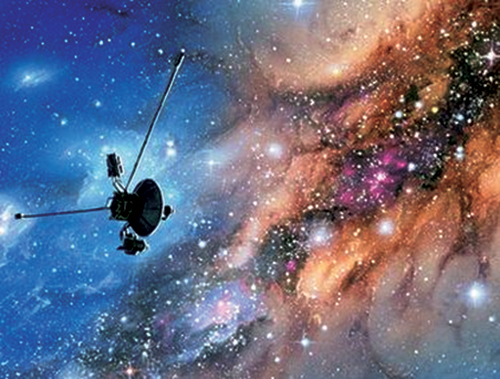A recent story in the International Herald Tribune got me thinking about the speed of modern communications and travel. It was about the ‘Voyager-1’ spacecraft. If you remember (are you old enough?), it was launched in 1977, the same year ‘Star Wars’, the movie, came out. And now, all these years later, Voyager-1 has exited our solar system, spinning out across the Milky Way.
It’s a breathtaking achievement, right up there with the moon landing and Mars rover. Voyager-1 has gone farther than any other human-made object. Ever.
By 1977 I had already been in Nepal most of 14 years. Looking back now (over 50 years on) I remember well what communication and travel were like in those daze - slow! I first landed here in 1963 in a noisy DC-3 Dakota aircraft from Delhi. We disembarked at Gauchar Field (previously a ‘gai charan’: cow pasture), now Tribhubvan International.
In those days my Peace Corps village was out west in the remote mid-hills district of Lamjung, the land of long moustaches (‘lamo-junga’), I was told. After flying to Pokhara we trekked two days east. Today, you can reach Lamjung from Kathmandu in a few hours by bus or taxi.
 Postal mail was our only means of communication with the outside world. We wrote home each week on a thin, greenish Nepal-international aerogramme that cost a pittance. Our village was on the historic ‘hulaki bato’, the old postal trail, so mail delivery was fairly reliable. It took only six weeks to receive an airmail reply, written (or typed, clickety-clack) on an equally thin, but bluish, American aerogramme. Does anybody remember what it was like to receive a hand written, stamped letter in the mail? (Old Nepali aerogrammes now sell for a price on the Internet, like museum specimens.)
Postal mail was our only means of communication with the outside world. We wrote home each week on a thin, greenish Nepal-international aerogramme that cost a pittance. Our village was on the historic ‘hulaki bato’, the old postal trail, so mail delivery was fairly reliable. It took only six weeks to receive an airmail reply, written (or typed, clickety-clack) on an equally thin, but bluish, American aerogramme. Does anybody remember what it was like to receive a hand written, stamped letter in the mail? (Old Nepali aerogrammes now sell for a price on the Internet, like museum specimens.)
Phone service was a single landline between Kathmandu and Pokhara, through Lamjung, with a series of stations located every half day’s walk along the postal trail (the walk took 7 days). Each station had an operator, and an old fashioned wall-mounted phone powered by two dry-cell batteries. Printed messages were received and resent orally by the operator up to 14 times before reaching us.
We always knew when a message was coming for us. We lived next to the telephone office and could hear the telephone-wallah loudly repeating each English letter as he copied it down in block letters: “Kathmandu ko ‘K’.” “Delhi ko ‘D’.” “Amrika (America) ko ‘A’.” “Europe ko ‘E’.” Et cetera.
We once got a message clearly addressed to us in Lamjung and clearly sent by the Peace Corps director in Kathmandu, but with the words in between (the important stuff) a jumble of random letters, unintelligible. The operators messed up royally that day.
Now we think nothing of using a cell phone and sending emails; ubiquitous and virtually instantaneous, worldwide.
Modern vehicles, too, especially spacecraft, are so technologically sophisticated that now, by comparison, Voyager-1 reminds us of primitive horse-and-buggy days. Voyager’s messages back to earth are powered by a whopping big(!) 23-watt transmitter. That’s the size of a dim refrigerator light bulb. It takes over 17 hours for a message to reach NASA. But that’s fast (faster than Kathmandu traffic), hurtling along at 61,155 kph across more than 18 billion kilometers of space.
It’s all relative. In the 1960s we thought that getting a letter from home every six weeks was a marvel of modern communications. Nowadays, we’re frustrated when we don’t have power enough in our digital devices to send or receive a text message to/from somewhere, anywhere, in under 10 seconds. Or 10 milliseconds.
Postscript: While writing this essay something strange occurred. The Internet station I was quietly listening to suddenly jumped track and began loudly trumpeting the bombastic motif of Gustav Holst’s symphony, ‘The Planets: Mars, the Bringer of War’. Da-da-da Dat Dat! - Da-da-da Dat Dat! Horns blaring. Cymbals crashing. Drums thundering. Eerily reminiscent of the ‘Star Wars’ theme.









